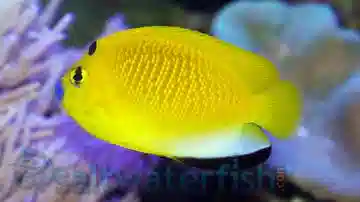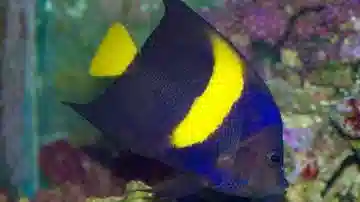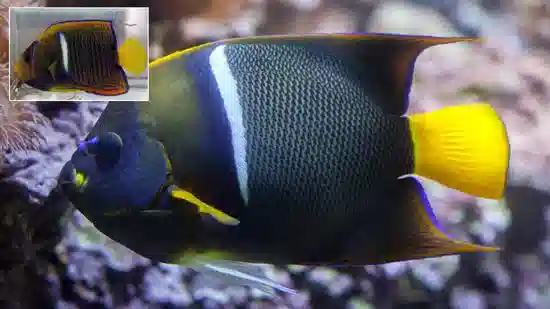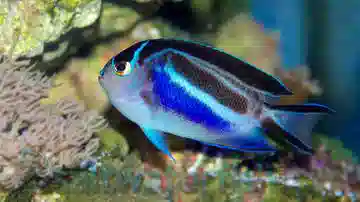Bellus Angelfish
Genicanthus bellus
(1 Reviews)
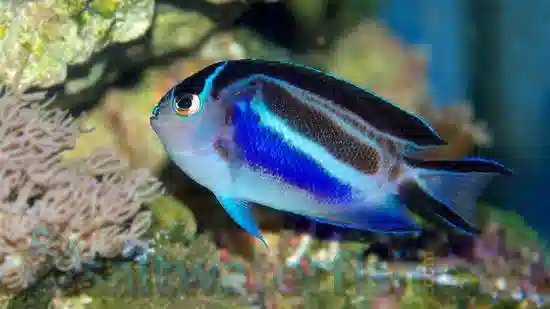

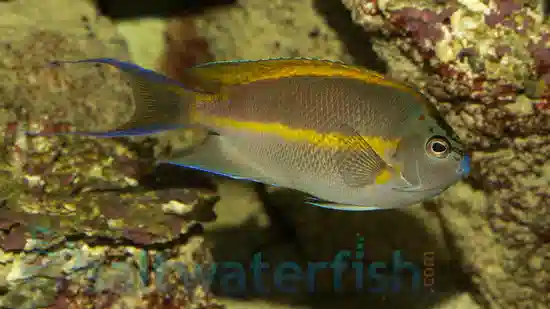
Bellus Angelfish
Genicanthus bellus
(1 Reviews)
{{ item.name }}
Size: {{ item.extra_field_3 }}
${{ getFormattedPrice(item.saleprice) }} ${{ getFormattedPrice(item.price) }}
To join the waiting list, click here
Free Shipping
With
$199.00
or more in Marine Life.
More details...
Bellus Angelfish Care Facts
| Care Level: | Moderate |
|---|---|
| Temperament: | Peaceful |
| Diet: | Omnivore |
| Reef Safe: | No |
| Minimum Tank Size: | 120 gallons |
| Max Size: | 7 inches |
Bellus Angelfish (Genicanthus bellus): A Comprehensive Guide
Welcome to the mesmerizing and captivating world of the Bellus Angelfish (Genicanthus bellus), a prized jewel in the world of saltwater marine aquariums. This exquisite fish, celebrated for its striking appearance and fascinating behavior, promises to be a standout in any well-maintained aquarium setup. With its unique characteristics and compatibility, the Bellus Angelfish has garnered the attention of seasoned aquarists and enthusiasts venturing into the captivating world of marine fishkeeping.
Habitat: The World of the Bellus Angelfish
The Bellus Angelfish originates from the tropical waters of the Western Pacific Ocean, where it inhabits coral-rich reefs and lagoons. In the wild, it can be found among the vibrant colors of corals, displaying a natural beauty that mirrors the hues of its habitat.
Reef Compatibility: Can the Bellus Angelfish Coexist with Reefs?
One of the remarkable traits of the Bellus Angelfish is its high level of reef compatibility. Like most other angelfish species, the Bellus Angelfish is considered not reef-safe. It occasionally exhibits destructive behavior towards corals or invertebrates.
Size and Lifespan: The Bellus Angelfish's Growth and Longevity
The Bellus Angelfish typically grows up to 7 inches in length with its striking, elongated body and vibrant coloration. Despite its relatively small size, this species can live for over ten years with proper care and a suitable environment. It offers aquarists the opportunity to nurture a captivating companion for an extended period.
Diet in Captivity: Feeding the Bellus Angelfish
To maintain the health and vibrancy of the Bellus Angelfish in captivity, providing a well-rounded diet is essential. This species is primarily herbivorous, feeding on algae and small invertebrates in the wild. In captivity, a diet that includes high-quality marine pellets, frozen foods like brine shrimp and mysis shrimp, and occasional servings of fresh algae or seaweed will ensure its nutritional needs are met and its colors remain vibrant.
Aquaculture and Availability: Sourcing Your Bellus Angelfish
The Bellus Angelfish is not commonly found in aquaculture. However, Saltwaterfish.com is committed to providing responsibly sourced fish whenever possible, ensuring that hobbyists can acquire healthy and acclimated Bellus Angelfish for their aquariums.
Sexual Dimorphism and Variations: Identifying the Bellus Angelfish
The Bellus Angelfish exhibits sexual dimorphism, which means that males and females have distinct physical characteristics. Males typically display a more elongated dorsal fin than females, while females tend to have a rounded dorsal fin. Additionally, juveniles exhibit different coloration compared to adults. Young Bellus Angelfish displays a stunning pattern of alternating vertical black and white stripes, transforming into a more subdued, adult coloration as they mature.
Compatibility and Temperament: The Bellus Angelfish's Social Behavior
The Bellus Angelfish is known for its peaceful temperament, making it a suitable candidate for community tanks. It generally gets along well with a variety of fish and invertebrates. However, it's essential to provide ample hiding spots and territories for all inhabitants to alleviate potential territorial disputes.
Tank Requirements: Creating the Ideal Environment for the Bellus Angelfish
Creating an optimal environment for the Bellus Angelfish necessitates meticulous attention to tank specifications. A tank with a minimum size of 120 gallons is recommended to accommodate its active swimming habits and territorial tendencies. Water conditions play a pivotal role in its well-being. Maintaining a pH level between 8.1 and 8.4, salinity at 1.020-1.025, and a consistent temperature of 72-78°F (22-26°C) mirrors its natural habitat and ensures its thriving presence.
Common Names: Other Names for the Bellus Angelfish
The Bellus Angelfish is also known by various names, including the Ornate Angelfish and the Blue Girdled Angelfish.
Compatible Tank Mates: Choosing Companions for the Bellus Angelfish
When selecting compatible tank mates for the Bellus Angelfish, choosing species that share a peaceful nature and can coexist harmoniously is essential. Here are five suitable companions:
- Flame Angelfish (Centropyge loriculus)
- Royal Gramma (Gramma loreto)
- Orchid Dottyback (Pseudochromis fridmani)
- Banggai Cardinalfish (Pterapogon kauderni)
- Coral Beauty Angelfish (Centropyge bispinosa)
Why Choose the Bellus Angelfish from Saltwaterfish.com
Saltwaterfish.com stands for quality and trustworthiness within the marine aquarium community. When acquiring a Bellus Angelfish from Saltwaterfish.com, you're not merely obtaining a stunning fish but investing in a piece of aquatic artistry. The company's commitment to providing responsibly sourced fish ensures that each Bellus Angelfish is healthy, acclimated, and ready to thrive in your aquarium. With a wide range of resources and customer support, Saltwaterfish.com provides a seamless journey towards nurturing and enjoying the captivating beauty of the Bellus Angelfish.
In conclusion, the Bellus Angelfish (Genicanthus bellus) is a captivating marine species that promises to enrich any saltwater aquarium. Its striking appearance, reef compatibility, and peaceful demeanor make it a highly sought-after addition among marine enthusiasts. By adhering to its specific requirements and considering its needs, aquarists can relish witnessing the Bellus Angelfish flourish within their aquatic habitat.
Beautiful Bellus Angelfish: Female swims in out of the rock formation in the saltwater fish tank. Healthy and energetic after acclimation.
Reviewed by: Orlando Asumata on Sept. 11, 2021


